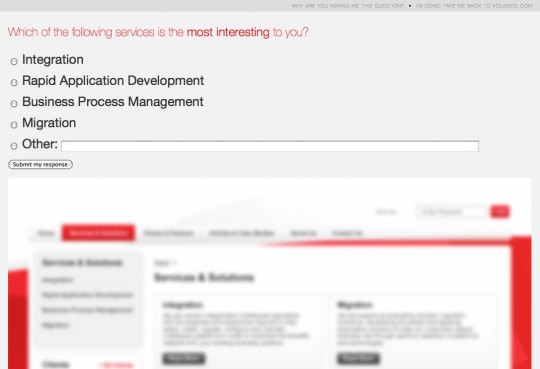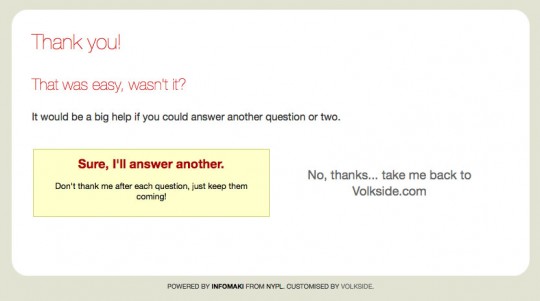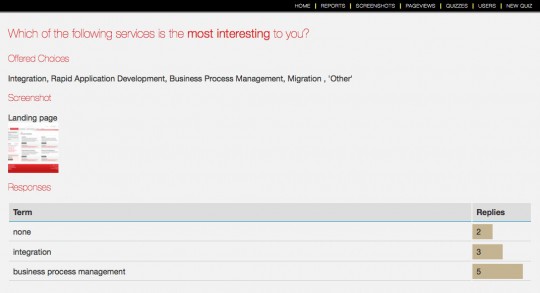Infomaki is usability software created by the Digital Experience Group of the New York Public Library. It is a tool for getting quick feedback from real users on how easy your website is to use and helps you conduct lightweight usability testing online.
Infomaki allows you to set up impression tests or “pageviews” that let you ask the user a quick, to-the-point question on a specific aspect of an existing or proposed web page design. In this respect Infomaki is similar to other usability testing tools like Fivesecondtest, Chalkmark and Usabilla.
Note: The screenshots in this post are from a client project and they’ve been edited slightly as the website is not yet released.
Infomaki also lets you create “quizzes”, simple multiple choice questions. In this regard it’s similar to traditional online survey tools like SurveyMonkey. Some usability testing tools like Loop11 allow multiple choice questions as well.
Note: Current version of Infomaki does not allow displaying a screenshot next to a multiple choice question as shown above, however it is relatively easy to customise the tool to add this functionality.
One question at a time
Infomaki is designed to collect feedback from the visitors to your public website. The default end-user experience is similar to Fivesecondtest as opposed to a more structured and lengthy process typically provided by tools like SurveyMonkey.
Infomaki asks user one question at a time, after which it confirms whether the user would like to finish up or answer another one. User can choose to continue until he or she has answered all the questions you have set up.
The order of questions is randomised, which means Infomaki in its current form is not suitable for structured surveys where later questions build up on the ones asked earlier.
A key design principle of Infomaki is that control always resides with the user. He or she is doing you a favour by answering even one question, and it is important to respect that.
Define test objectives and questions
It is critical you define the objectives for your Infomaki usability testing, just like when testing an information architecture.
Once you have worked out your overall objectives you can write up the questions you want users to answer about your existing or proposed web page designs. Getting the question right is critical. Make sure your questions are clear and concise, and provide just enough context for the users to be able to answer them easily.
Here’s a couple of impression test (“pageview”) questions from a recent client project:
- “You are looking for contact information for Acme Corporation. Please click the page below on where you would go for this information.”
- “What is the most important thing on the page below for you? Please click.”
We also asked the target audience multiple choice questions (“quizzes”) like the following:
- “Which of the following services is the most interesting to you?” [multiple choice]
- “What would you change about this page? Please describe in one sentence” [open-ended]
Decide your testing approach
You can conduct usability testing with Infomaki in a number of ways:
- Ongoing unmoderated testing available to anyone visiting your public website
- Unmoderated private testing targeted at users specifically recruited for the testing, typically with a time limit
- Moderated in-person testing with recruited users
New York Public Library use Infomaki for ongoing testing, which is also reflected in the tool’s design (see “One question at a time” section above for an example).
The specific project circumstances and your test objectives will determine which type of testing is most appropriate. We recently ran user testing using Infomaki with the second approach with very successful results.
Review results
Infomaki offers useful report on the clicks users have made in response to an impression test question:
You can also review the responses users provided to a particular multiple choice question:
The multiple choice reporting is quite rudimentary and in practice I found it easier to export results from the database and review and analyse them outside Infomaki.
In closing
Infomaki makes getting feedback from your users easy and promotes continuous improvement by means of ongoing user testing. Infomaki is also designed to acknowledge that the users are doing you a favour by taking the time to provide feedback, which I feel is really important.
The administrative user interface of Infomaki is somewhat clunky and the workflow for setting up tests could be more streamlined. As you can tell by the version number 0.1.1 it is a young project and likely to get many user interface improvements and more features in the future.
It is fantastic that NYPL decided to publish Infomaki as an Open Source project. Sure it’s got many rough edges but since you have full access to the source it’s easy to polish those and customise the tool to suit your particular situation. Perhaps some of your changes are relevant to be published back to the wider community, too!
Please take Infomaki for a spin and post your experiences below!
Further reading
- Konigi: NYPL Labs Infomaki: A lightweight usability testing service
- NYPL Labs blog: Infomaki goes Open Source
- NYPL public Infomaki survey
You may also be interested in the following related posts from us:
- Using Treejack to test your website structure
- Naview: Navigation preview tool for rapid IA prototyping
If you need hand in preparing or conducting usability testing please contact us.
Update 6 Jul 2009: Minor edits in excerpt and introduction paragraphs.





Thanks so much for sharing your experiences with Infomaki! We’re thoroughly excited to see what people are doing with it in the real world, and you’re one of the first we’ve seen to get it up and running. Totally true about the rough edges… this first release was just thrown out there as-is; upcoming releases promise to be much easier to customize and configure. But keep an eye on the NYPL Labs web site for upcoming releases.
No worries at all Michael, I’m glad you found the article useful.
If I wanted to share some ideas for further development, is the Infomaki SourceForge project page the best place to post them?
Thanks again for releasing this great tool; I’ll definitely be keeping an eye on the NYPL Labs website for updates!